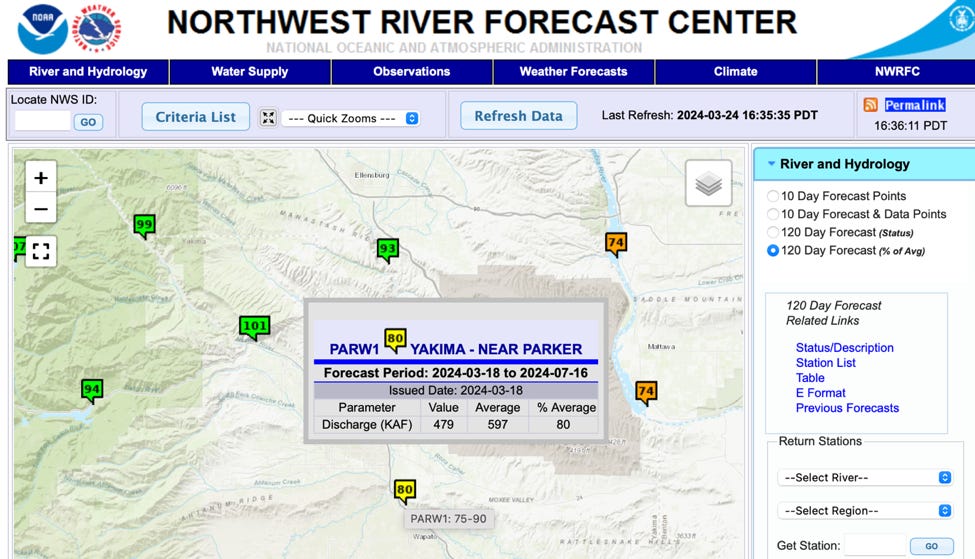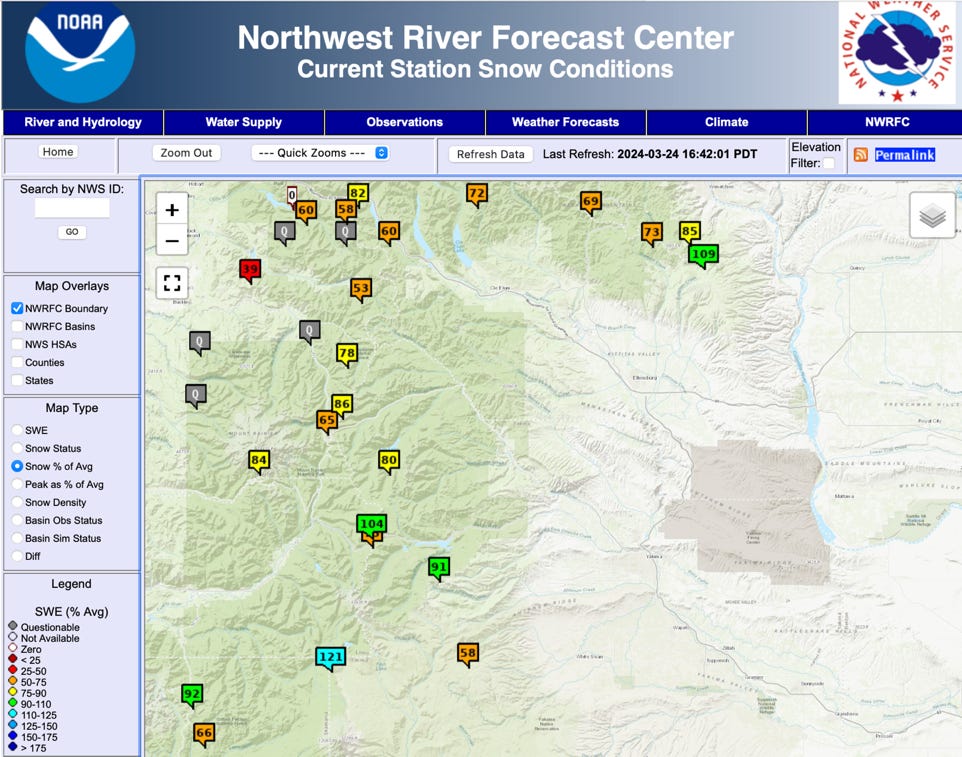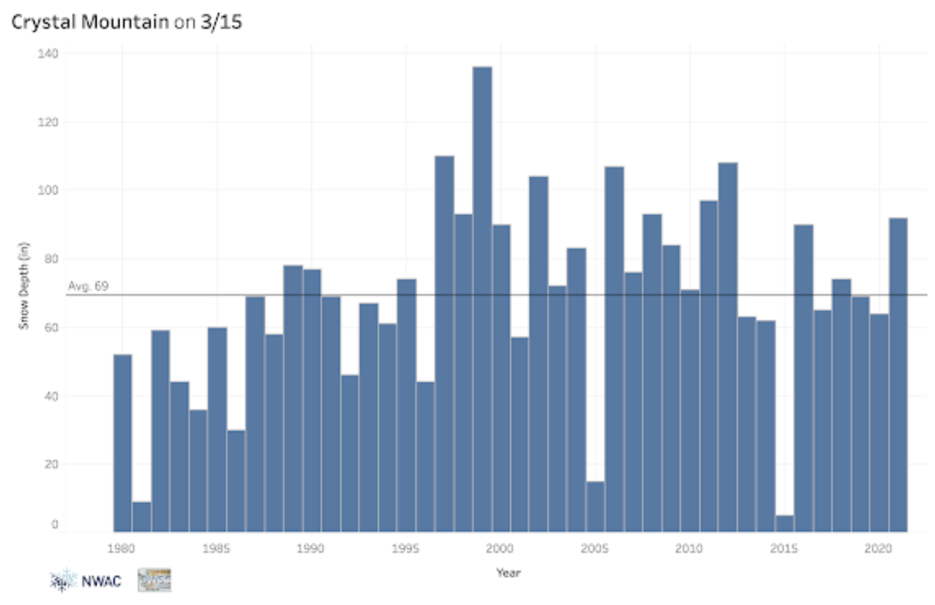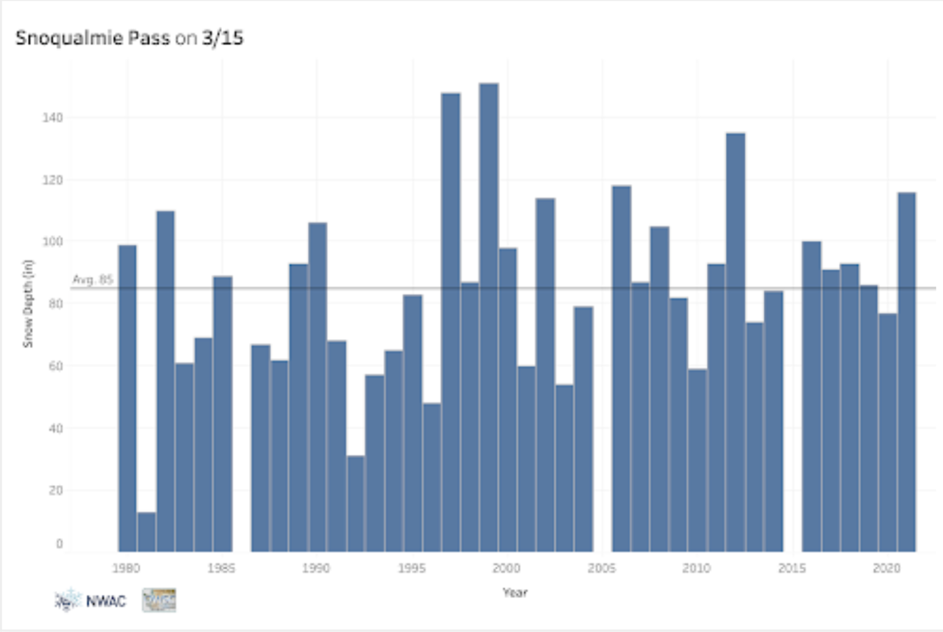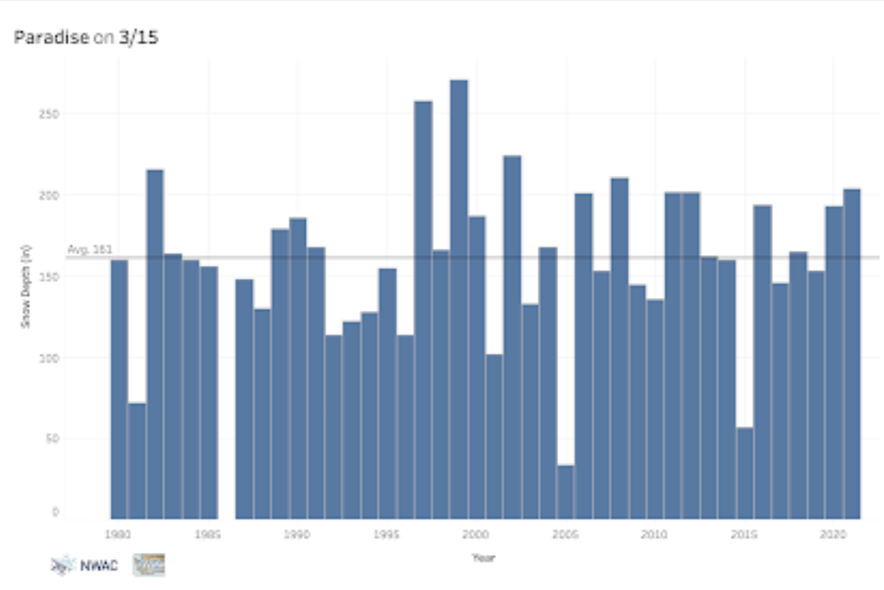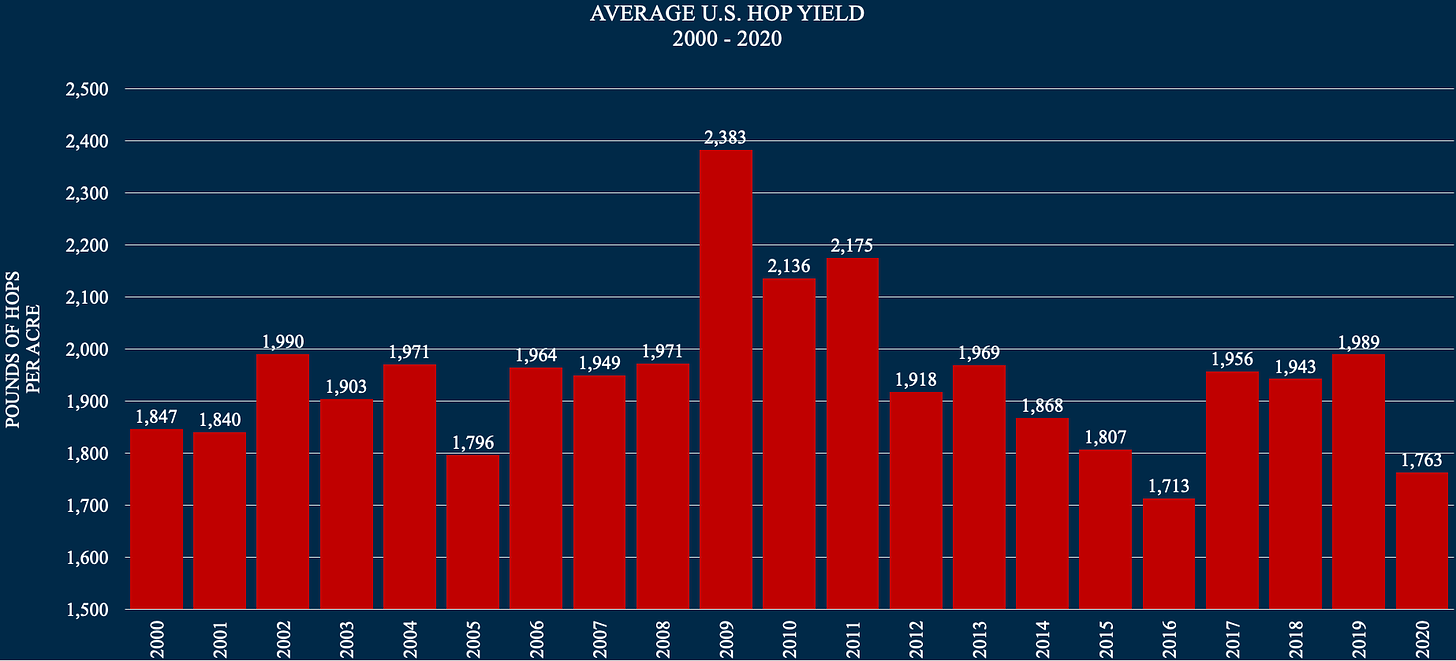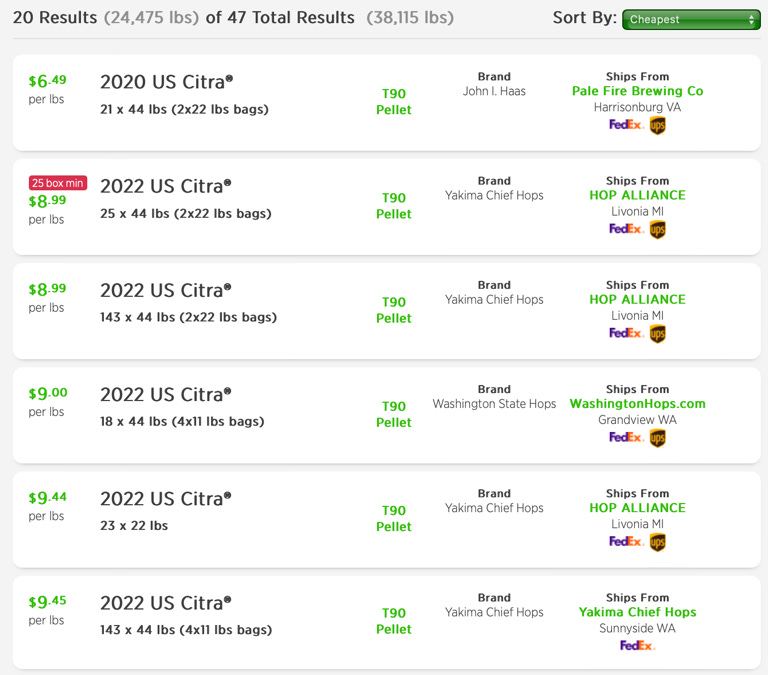Water, Labor, A Citra Market Update, and the Bridge Collapse & how they Relate to hops.
The MacKinnon Report April 2, 2024
THINKING OUT LOUD
This is the time of the year when it appears there’s not much happening in the hop industry. Like a duck that appears calm on the surface, there’s a lot of activity under the surface.
In this edition of the MacKinnon Report, I discuss in why you should never believe reports that the hop crop may be threatened due to a lack of water. I explain why the U.S. and the EU may have no choice but to encourage mass immigration and why labor problems may be a thing of the past. I provide an update on the state of the Citra® Brand HBC 394 market. Finally, I discuss the symbolism of the Baltimore bridge collapse. Find out how these things are related to the hop market and affect the price of beer going forward.
WATER WATER EVERYWHERE
In February, there was a lot of news of a light snowpack in the Cascade mountains[1]. Nervous articles referenced the El Nino cycle and climate change in this article[2]. The “Climate Lab” at the Seattle Times implied in February there was little hope for the snowpack in the months ahead[3]. These articles are recycled every year in February and March. Here’s one from 2023[4]. Here’s one from 2022[5]. Here’s one from 2021[6]. Here’s one from 2020[7]. I could go on, but you get the point.
Every year, farmers point to these articles in February or March and imply the possibility of a lack of water for their crops in the Yakima valley. The problem with that is that winter is not over when the articles are recycled. It’s possible that it won’t snow anymore in any given year because weather is infamous for its unpredictability. Everybody who lives around the Cascade mountains knows that February is too early to call the end of winter. It’s far too early to predict disaster as I publish this article in April. As this reporter admits, snowpack often peaks by April 1st. The article continues, “but we’ve seen plenty of seasons where through like April 15 we can still get some pretty significant snow in the mountains”[8]. Brewers who don’t live near the Cascades don’t know this, so they are vulnerable to propaganda.
“Profit is sweet, even if it comes from deception.”
- Sophocles
THE CALM BEFORE THE STORM
There’s not much action in February and March on the farmer side of the hop world. It’s the time of year in the Yakima valley when farmers can still plant if they can sell some hops they haven’t already planted. After a winter of looking at empty hop yards, farmers are ready to get the season going. They can be anxious about the coming year if the market isn’t good. They know every brewer fears not getting their hops because, as people around the world say, “without hops there is no beer”[9][10][11][12][13]. Adding the inference that this year’s crop might be short due to a lack of water can’t hurt.
SNOWPACK
Yakima is a semi-arid desert and gets about eight inches (20.32 cm) of rain each year[14]. Irrigation water for crops relies on the mountain snowpack that runs through the rivers all summer. What matters is the Snow Water Equivalent (SWE). You can check snowpack levels and the Snow Water Equivalent (SWE) levels for yourself on a USDA Natural Resources Conservation Service snow and water interactive map.
In 2024, the SWE in the Cascades is above the 30-year average. Based on the current snowpack and the river forecasts, there will be plenty of water to produce the 45,000 – 50,000 acres (18,218 – 20,242 ha.) farmers in the Pacific Northwest (PNW) will produce in 2024 (Figures 1 & 2) [15].
Figure 1. 120-day river forecast
Source: NOAA
Figure 2. Snow percent of average in mountains surrounding Yakima
Source: NOAA
According to the Hop Growers of America statistical report, the U.S. hop industry reached peak hop acreage in 2021 with 62,259 acres (25,206 ha.). In 2023, U.S. hop farmers harvested 55,710 acres (22,554.6 ha.)[16]. Much of their trellis … and the capacity to irrigate it remains available in 2024. When farmers begin to remove trellis from the ground, that will signal the industry has understood the need for change.
HOW MUCH IS ENOUGH?
In 2005, snowpack in the cascades was one-third of normal[17]. In 2015, a drought in the Yakima valley led to lower yields[18]. Water levels in the upper Yakima basin were 23% of normal[19]. Snowpack in 2005 and 2015 were far below average. Snowpack from several stations around the Cascades reflect the deficit (Figures 3, 4, & 5).
Figure 3 Crystal Mountain Snow Depth on March 15th of each year.
Source: https://cliffmass.blogspot.com/2021/03/the-northwest-snowpack-trend-of-past.html
Figure 4. Snoqualmie Pass Snow Depth on March 15th of each year.
Source: https://cliffmass.blogspot.com/2021/03/the-northwest-snowpack-trend-of-past.html
Figure 5. Paradise (Mt. Rainier) Snow Depth on March 15th of each year.
Source: https://cliffmass.blogspot.com/2021/03/the-northwest-snowpack-trend-of-past.html
The question is not the level of the snowpack. The question brewers should care about is what effect a low snowpack has on U.S. hop production. The answer is not much. The issue is water rights and accessibility. People with senior water rights get water before others. Nevertheless, in a drought situation, farmers like Brad Carpenter, who has less desirable water rights, was able to shuffle around water rights from neighbors to access water during drought years[20][21]. According to the USDA, during the worst snowpack years (i.e., 2005 and 2015) the decrease in average U.S. hop yields was less than 10% from the previous year (Figure 6).
Figure 6. Average U.S. hop yield for the Pacific Northwest from 2000-2020
SOURCE: USDA NASS NATIONAL HOP REPORT 2000-2020
You may notice in figure 6 above that in 2016 hop yields decreased from 2015 despite the presence of ample snowpack. According to Blake Crosby, President of Crosby Hop Farms, in 2016, those low yields resulted from lower-yielding aroma varieties[22]. In a future article, I will discuss who has the most environmentally friendly varieties.
Next February or March, when you read reports of low snowpack in the Cascades, don’t worry. If some ambitious hop farmer decides to highlight it and infer it may impact the coming crop, take it with a grain of salt. Even during years when there is not a massive surplus of tens of millions of pounds of hops languishing in warehouses around the world, the way the system works there can never be an actual shortage. I’ll explain why that’s true in a future article.
LABOR PAINS
Immigrants are flooding into the U.S. and the EU. By October, there will be an estimated eight million asylees in the U.S. from around the globe[23][24][25]. In the U.S., there are two types of immigrants, undocumented (i.e., illegal) and asylum seekers, which are in the U.S. legally according to 2021 rule changes under the Biden administration[26]. The difference is important. It will affect agricultural labor. Refugees and asylees are allowed to work[27][28]. According to the “Asylum Seeker Work Authorization Act of 2023”, asylum seekers are entitled to an expedited work permit, which can take as little as 30 days to receive[29].
In theory, undocumented people are not allowed to work. In 2024, however, they have some of the same rights as citizens[30][31]. In testimony before the “Subcommittee on Health, Employment, Labor, and Pensions, of the Education and the Workforce Committee” on September 13, 2023, Steven A. Camarota, Director of Research at the Center for Immigration Studies testified that there were an estimated 12.6 million illegal immigrants in the U.S. as of May 2023. Of that 12.6 million, he estimated nine million had entered the workforce[32].
There are politicians that want to legalize undocumented immigrants and give them a path towards citizenship[33][34][35]. The bipartisan Dignity Act[36], which is not expected to pass, would create several ways for illegal immigrants to become legal[37][38].
SOCIAL PROGRAM COLLAPSE
In 2023, the US has lowest birthrate in over 200 years at 12.2 per 1,000 people[39][40]. Replacement theory has been politicized and labeled by those on the left as right-wing racism[41]. That’s a distraction. Again, you need to follow the money. Potential workers are being brought into the U.S. at a faster rate than ever before[42]. This has nothing to do with race. It is about financing the future. Janet Yellen, U.S. Secretary of the treasury, said on March 27, 2024 that there is a $175 trillion gap in social security and Medicare funding[43]. You can view that and other statistics including the U.S. national debt for yourself on this fun web site.
Figure 7. U.S. Debt Clock
Source: www.usdebtclock.org
The low number of births will translate into fewer younger workers paying into the tax system. That threatens retirement schemes in the U.S., which is set up as a Ponzi scheme. The White House admitted that immigrants must be legally ushered into the workforce as quickly as possible to become taxpayers or the social system will collapse[44]. No politician wants that to happen while they are in office. The same problem plagues the EU[45][46].
LABOR PROBLEMS NO MORE
This affects the price of a beer. Labor has traditionally been one of the challenges hop farmers often cite when talking about the difficulties of their work[47][48][49]. Labor needs surge in the spring when hops are twined and trained and again during harvest. Since 1986, the U.S. has arranged for “guest workers” to temporarily come to the U.S. to work in agriculture under the H2A visa program[50]. The number of H2A workers has increased 1,700% since 2009[51]. Washington State ranks third after Florida and California in the number of temporary workers it imports under the program[52]. In 2023, one hop farm had as many as 500 H2A employees each of which cost between $16.00 and $17.99 per hour[53][54]. The program provided temporary workers for years. It too is a bureaucratic nightmare, but it works. The larger problem with H2A visa holders is that the IRS does not withhold money from worker paychecks for Social Security and Medicare since they are beneficiaries[55] (i.e., they don’t help solve the United States’ insolvency problem).
Trump has said he will round up migrants and send them home. That is popular among his base[56]. It’s hard to imagine how such an effort might work without imposing a police state[57][58]. His opponents will certainly make comparisons to the last time so many millions of people were rounded up 91 years ago[59]. Trump has broken campaign promises in the past. All politicians do. He promised to build the wall with Mexico in 2016. He promised to release all the documents regarding the JFK assassination. Once in office, he decided it wasn’t prudent. When Trump’s economic advisors show him that his options are to either allow tens of millions of migrants to stay and pay taxes, cut Social Security and Medicare benefits to elderly Americans, or raise taxes his choice will be obvious, a compromise that looks like action but falls far short of his stated goal. The silver lining to what appears to some to be a dark cloud is that labor problems may be a thing of the past once asylees are required to work.
CITRA® BRAND HBC 394 MARKET UPDATE:
In my March 14, 2024 article, “Collaboration, bankruptcy, low hop prices, two predictions and more”, I mentioned a listing for 1,100 pounds (500 kilos) of “2020 U.S. Citra®” available for $4.00 per pound (Figure 8). https://mackinnonreport.substack.com/p/themackinnonreport
Figure 8. March 14, 2024 listing for Citra® Brand HBC 394 hops
Source: Lupulin Exchange from March 14, 2024
On April 2nd, I checked on Lupulin Exchange to see if the hops were still there. They weren’t (Figure 9). I followed up with the seller to see if he had sold the hops at $4.00 per pound. They didn’t sell. When what was the most popular proprietary hop variety does not sell at a fraction of its former cost, it is a sign that the market has changed. Demand is all but gone. The market is flooded and needs to find the price at which hops will move once again. If those hops have been stored properly, which I am told they were, they likely have lost only a small part of what makes the variety so special. If nothing else, they would be a cheap alpha bittering option … but there was no interest. I wonder if they would move at $2.00 per pound. If you’re a brewer and might be interested at that price, let me know. They’re not my hops to sell, but I can let the owner know. Maybe you’ll get a great deal.
If this continues through summer, brewers will
see fire sale prices prior to harvest as merchants try to clear their warehouses to make space for the 2024 crop.
Figure 9. Citra® Brand HBC 394 hops cheapest listings on April 2, 2024
Source: Lupulin Exchange
BALTIMORE BRIDGE SYMBOLISM
Many media outlets reported that the Baltimore bridge incident would create problems with the supply chain[60][61][62][63]. Immediately, conspiracies surfaced[64]. Once people calmed down, we learned the ship had serious electrical problems while still in port[65]. Reports that the bridge collapse would disrupt the supply chain were exaggerated. Excess capacity at other ports across the eastern seaboard will make up the lost shipping capacity in Baltimore[66][67].
HANLON’S RAZOR:
“Never attribute to malice that which can be explained by neglect, ignorance or incompetence.”[68]
- Robert J. Hanlon[69]
The symbolism of the bridge bearing the name of the author of the U.S. national anthem could not be more obvious[70]. The situation in Baltimore brought attention to the state of American infrastructure, which badly needs updating[71]. There is another symbolism that has not been fully explored. Estimates are that rebuilding the Baltimore bridge will cost $2 billion and could take up to a decade[72][73].
The problem is not a lack of technical expertise. In 1931, Americans built the Empire State building in 410 days[74]. People can do amazing things … if they are allowed to. According to Jamie Dimon, CEO of JPMorgan, bureaucracy has crippled the U.S. and hinders progress[75]. The Baltimore bridge is the most recent example, but there are many. For example … The U.S. has lost its global dominance in nuclear energy. It has 95 power plants in operation and one under construction. The permitting process is the primary obstacle[76]. China, on the other hand, has 21 nuclear power plants under construction[77].
HOP BUREAUCRACY
The hop industry has become a victim of bureaucracy. Twenty years ago, the industry was almost unregulated. You could walk into somebody’s office or have a look at one of their fields if you wanted. Today, you need to sign in and have a badge to walk in a field. American hop farms became corporate. In the process, they lost part of their soul. They are expected to have multiple certifications to demonstrate standards of quality, or that they care about the environment. I may have missed some, but here’s a pretty good list:
HAACP (Hazard Analysis Critical Control Point)[78]
ISO9000 (International Organization for Standardization)[79]
FSSC 22000 certification, which is part of the ISO-based Global Food Safety Initiative (GFSI) program. Brewers Supply Group mentions on their website that they have the FSSC certification[88].
LEED (Leadership in Energy and Environmental Design) Gold certified building[89]. The John I. Haas Innovation center located in Yakima is a LEED certified building. This means their office building is greener than traditional construction[90].
Yakima Chief Hops™ (YCH) has their Green Chief® program[91]. According to its website, it is through the Green Chief® program YCH controls the many variables on the 25 participating farms to ensure they get the proper quality.
Sustainability reports. There are too many examples of these in the hop industry to list.
I assume each of these ideas was born of good intentions. Each stands for something that is hard to argue with, like protecting the environment, or safety.
These certifications as sometimes used as marketing tools to virtue signal and to gain a competitive advantage. They are even advertised as such by companies who exist to help other companies get certified[92]. Certifications like this favor large companies. Small farms are discounted because they cannot scale to feed a growing population[93]. Larger farms can afford the additional expense of a compliance officer. On smaller farms (think any European hop farm) that responsibility falls on the owner. The extra time and expense is not justified because there is no additional return.
FUN FACT: Hops in the U.S. today are baled in new polypropylene bales every year. Twenty years ago, farmers recycled burlap bales for several seasons. Money was tight. Buying new burlap each year was wasteful. The old burlap still worked so they used it. During the past 10-15 years, craft brewer concern over food safety due to the increased popularity of dry hopping, changed that[94].
Breweries don’t pay extra for these certifications, for the additional cost of using new poly bales, for painting and cleaning the inside of picking machines, or for the compliance person most companies have on staff. You could say breweries have been paying inflated prices for the past 15 years, and these things were included in those prices. That’s true. As prices decrease, however, the lack of compensation for these practices will attract attention.
As prices decline, acreage shrinks, and money is tight, farmers will look for ways to cut corners. Before certifications were available, the market certified who had the best quality hops. Does Global G.A.P. or Kosher certification improves the quality of the hops.
FLASHBACK: I was a Peace Corps volunteer in Latvia right after the fall of the Soviet Union. In the early 90s, many of the Soviet practices were still in place. One that didn’t seemed ridiculous at the time was that every document had to have a stamp to be official. If you didn’t have a stamp on your document, it was worthless in the eyes of the office plankton who checked for those things. The stamp was more important than the contents of the document. Those who controlled the stamps took their job seriously. They did not stamp documents lightly and they could impede your progress on important projects. I discovered a shop in Riga where I could order custom stamps. Because it was no longer the Soviet Union, the stamp company didn’t care what my stamp said on it. When I told them my idea to create a very official looking stamp, I think they were happy to be a part of bucking the system. That was the attitude in the Former Soviet republics in the 1990s. I shared my idea with some of the other volunteers. We all made stamps to streamline our certification needs and life became much simpler.
Most hop farmers around the world I’ve met produce high quality hops most of the time. They’ve mastered the hard part. Today’s bureaucracy adds additional costs and makes an already difficult job more difficult. Certifications are a biproduct of ESG regulations, which will intensify in 2024[95][96]. ESG started at the United Nations in 2005. No surprise, it’s about money … big money. ESG mandates by investors is anticipated to represent $50 trillion in 2025[97]. Investors want to be seen as investing in companies perceived to be responsible. ESG represents the metrics by which companies are rated. The actual rating system is not disclosed[98]. Public companies requiring these certifications of their suppliers are doing so because they need to keep investor money flowing. It reminds me of the all-important Soviet stamp.
As prices decrease, and times get more difficult, will entrepreneurial farmers find ways to work around the system? I think some will. Will the hops be lower quality?
[1] https://www.kuow.org/stories/washington-s-snowpack-is-suffering-this-winter-it-s-not-going-to-get-much-better
[2] https://www.heraldnet.com/news/warm-winter-melts-meager-snowpack-in-cascades-with-far-reaching-effects/
[3] https://www.seattletimes.com/seattle-news/climate-lab/was-snowpack-languishes-with-little-hope-for-the-months-ahead/
[4] https://kimatv.com/news/local/state-of-the-snowpack-february-7-2023-compared-to-last-year-washington-weather-california-snow-cascades-puget-sound-seattle-oregon-la-nina-mountains
[5] https://www.king5.com/article/tech/science/environment/washingtons-mountain-snowpack-threatened/281-d470f42b-359a-46f2-aabe-802d2a45a491
[6] https://www.opb.org/article/2021/03/10/cascade-snowpack-climate-change-water-supply-wildfire-risk/
[7] https://www.npr.org/2020/02/18/803125282/how-warming-winters-are-affecting-everything
[8] https://www.king5.com/article/tech/science/environment/washington-state-snowpack-april/281-d3724739-0c79-49f9-a9cc-925cecead8f8
[9] https://thecraftyboozecompany.co.uk/hops-a-brief-overview/
[10] https://www.themanual.com/food-and-drink/what-are-hops-sam-adams-jim-koch-hallertau-harvest/
[11] https://beermapping.com/location/11181
[12] https://www.amazon.de/171-All-About-Hops/dp/B0CSJ9WDNR
[13] http://royfarms.com/no-beer/
[14] https://www.yakimaherald.com/news/local/yakima-received-roughly-same-amount-of-precipitation-this-weekend-as-past-three-months-combined/article_fa369a26-3610-11ee-98f3-cfe1106efacd.html
[15] https://www.nwrfc.noaa.gov/snow/snowplot.cgi?CSTO3
[16] https://www.usahops.org/img/blog_pdf/474.pdf
[17] https://www.latimes.com/archives/la-xpm-2005-feb-22-os-nosnow22-story.html
[18] https://www.ncbi.nlm.nih.gov/pmc/articles/PMC7970847/
[19] https://apps.ecology.wa.gov/publications/documents/1611001.pdf
[20] https://www.marketplace.org/2017/02/17/washington-state-mulls-plan-help-keep-water-flowing-high-value-crops/
[21] Although they are competitors, I have always been impressed to see how hop farmers help one another during times of need like droughts and kiln fires. It proves that sometimes there are things more important than money to some people.
[22] https://brewpublic.com/beer-news/2016-usa-hop-harvest-yields-87-1-million-pounds-of-hops/
[23] https://www.axios.com/2024/03/02/data-biden-border-crisis-immigration-8-million-detention#
[24] https://www.cfr.org/backgrounder/seeking-protection-how-us-asylum-process-works
[25] https://www.bbc.com/news/world-us-canada-68609930
[26] https://www.migrationpolicy.org/news/biden-asylum-processing-proposed-rule
[27] https://www.uscis.gov/sites/default/files/document/guides/D2en.pdf
[28] https://www.nilc.org/issues/economic-support/table_ovrw_fedprogs/
[29] https://immigrationforum.org/article/asylum-seeker-work-authorization-act-of-2023-bill-summary/
[30] https://esd.wa.gov/unemployment/citizenship-and-legal-rights
[31] https://legalaidatwork.org/factsheet/employment-rights-of-undocumented-workers/
[32]https://edworkforce.house.gov/uploadedfiles/9.13.23_camarota_testimony_help_subcommittee_hearing_on_open_borders_and_workforce.pdf
[33] https://www.yahoo.com/news/activists-chicago-call-biden-administration-014834779.html
https://immigration.procon.org
[35] https://www.fwd.us/news/pathway-to-citizenship/
[36] https://immigrationforum.org/article/the-dignity-act-bill-summary/
[37] https://escobar.house.gov/uploadedfiles/the_dignity_act_of_2023_one_pager.pdf
[38] https://www.govtrack.us/congress/bills/118/hr3599
[39] https://www.statista.com/statistics/1037156/crude-birth-rate-us-1800-2020/
[40] https://www.cia.gov/the-world-factbook/field/birth-rate/country-comparison
[41] https://www.pbs.org/newshour/politics/what-is-great-replacement-theory-and-how-does-it-fuel-racist-violence
[42] https://www.project-syndicate.org/commentary/immigration-crucial-to-united-states-economic-growth-by-anne-o-krueger-2024-03
[43] https://www.tftc.io/social-security-medicare-funding-crisis/
[44] https://www.whitehouse.gov/wp-content/uploads/2024/03/ERP-2024-CHAPTER-3.pdf
[45] https://www.euronews.com/next/2023/04/04/china-sees-first-population-decline-in-six-decades-where-does-the-eu-stand
[46] https://www.reuters.com/world/europe/migration-pushes-eu-population-back-growth-2022-2023-07-11/
[47] https://www.spokesman.com/stories/2021/sep/07/hop-harvest-underway-in-the-yakima-valley-with-gro/
[48] https://www.marketplace.org/2022/07/21/strong-dollar-squeezing-profits-washington-state-farmers-hops-exports/
[49] https://www.crosbyhops.com/news-blog/blog/2022-hop-report
[50] https://nfwm.org/farm-workers/farm-worker-issues/h-2a-guest-worker-program/#:~:text=The%20Immigration%20Reform%20and%20Control,to%20be%20full%20of%20abuses.
[51] https://www.npr.org/2023/07/27/1187682674/farm-workers-guest-workers-h-2a-visa-agricultural-harvest-farm-labor
[52] https://www.dol.gov/sites/dolgov/files/ETA/oflc/pdfs/H-2A_Selected_Statistics_FY2023_Q2.pdf
[53] https://www.uscis.gov/tools/reports-and-studies/h-2a-employer-data-hub
[54] https://www.uscis.gov/sites/default/files/document/data/FY%202023%20H-2A%20Employer%20Data.csv
[55] https://www.irs.gov/individuals/international-taxpayers/foreign-agricultural-workers
[56] https://www.latimes.com/politics/story/2024-03-25/column-trump-wants-to-round-up-over-a-million-undocumented-migrants-from-california-heres-how-he-might-do-it#:~:text=Here's%20how%20he%20might%20do,in%20Texas%20and%20expel%20them.
[57] https://www.reuters.com/world/us/trump-plans-sweeping-undocumented-immigrant-roundups-detention-camps-report-2023-11-11/
[58] https://edition.cnn.com/2016/01/19/politics/donald-trump-deportation-mexico-eisenhower/index.html
[59] https://encyclopedia.ushmm.org/content/en/article/nazi-camps
[60] https://www.bbc.com/news/world-us-canada-68672373
[61] https://www.washingtonpost.com/business/2024/03/27/baltimore-port-economy-disruption-bridge-collapse/
[62] https://www.theguardian.com/us-news/2024/mar/27/baltimore-bridge-collapse-economic-impact-francis-scott-key-us-port-shipping-traffic
[63] https://www.npr.org/2024/03/27/1241134460/baltimore-bridge-collapse-supply-chains-auto-imports
[64] https://www.forbes.com/sites/maryroeloffs/2024/03/27/baltimore-bridge-collapse-sparks-wild-conspiracies---though-officials-continue-to-dispel-them/?sh=f16ec7e7c760
[65] https://www.dailymail.co.uk/news/article-13246079/Dali-cargo-ship-suffered-severe-electrical-problem-docked-Baltimore-days-prior-bridge-collapse-crash-saw-suffer-total-power-failure-loss-engine-failure-port-worker-says.html
[66] https://www.reuters.com/world/us/baltimore-bridge-port-blockade-wont-trigger-new-supply-chain-crisis-experts-say-2024-03-27/
[67] https://www.vox.com/2024/3/27/24112995/baltimore-bridge-collapse-dali-shipping-panama-houthis
[68] https://modelthinkers.com/mental-model/hanlons-razor#:~:text=Hanlon's%20Razor%20is%20a%20reminder,by%20neglect%2C%20ignorance%20or%20incompetence.
[69] https://policyoptions.irpp.org/authors/robert-j-hanlon/
[70] https://amhistory.si.edu/starspangledbanner/the-lyrics.aspx
[71] https://eu.usatoday.com/story/news/nation/2024/03/27/baltimore-bridge-collapse-how-safe-are-americas-bridges/73113103007/
[72] https://www.voanews.com/a/after-bridge-collapse-maryland-governor-urges-congress-to-pass-funding-for-rebuild/7551476.html
[73] https://www.wypr.org/wypr-news/2024-03-27/baltimores-key-bridge-rebuild-could-take-a-decade-analysts-say
[74] https://www.esbnyc.com/about/facts-figures
[75] https://uk.news.yahoo.com/jpmorgan-ceo-jamie-dimon-says-150005321.html
[76] http://large.stanford.edu/courses/2017/ph241/park-k2/
[77] https://www.cnbc.com/2023/08/30/how-china-became-king-of-new-nuclear-power-how-us-could-catch-up.html
[78] https://food.unl.edu/article/haccp-seven-principles
[79] https://www.iso.org/standards/popular/iso-9000-family
[80] https://salmonsafe.org/get-certified/
[81] https://www.goschiefarms.com/sustainability
https://www.ok.org
[83] http://royfarms.com/certifications/
https://www.globalgap.org
[85] https://cornerstoneranches.com/ethos/sustainability/
https://www.sqfi.com
[87] https://www.crosbyhops.com/shop-hops/whole-leaf-hops
[88] https://bsgcraftbrewing.com/bsg-hops-facility-receives-fssc-22000-certification/
[89] https://betatec.com/wp-content/uploads/2022/10/HAAS-Sustainability-Report-2021.pdf
[90] https://www.chase.com/personal/mortgage/education/owning-a-home/what-is-leed-certification
[91] https://careers.yakimachief.com/green-chief/
[92] https://www.sgs.com/en/services/esg-certification
[93] https://agfundernews.com/esg-agriculture-the-overlooked-giant-in-the-conversation
[94] Dry hopping does not expose the hops to boiling temperatures and therefore cannot kill bacteria that might be on the hops.
[95] https://sustainabilitymag.com/esg/esg-policy-and-regulation-what-to-prepare-for-in-2024
[96] https://www2.deloitte.com/ce/en/pages/global-business-services/articles/esg-explained-1-what-is-esg.html
[97] https://www.barrons.com/articles/esg-investing-climate-un-environment-51663620697
[98] https://www.greenbiz.com/article/esg-score-calculation-how-find-your-companys-rating-part-1




